World War II
American Air and Nautical Almanacs
“Computerized” by
Columbia University's Wallace Eckert
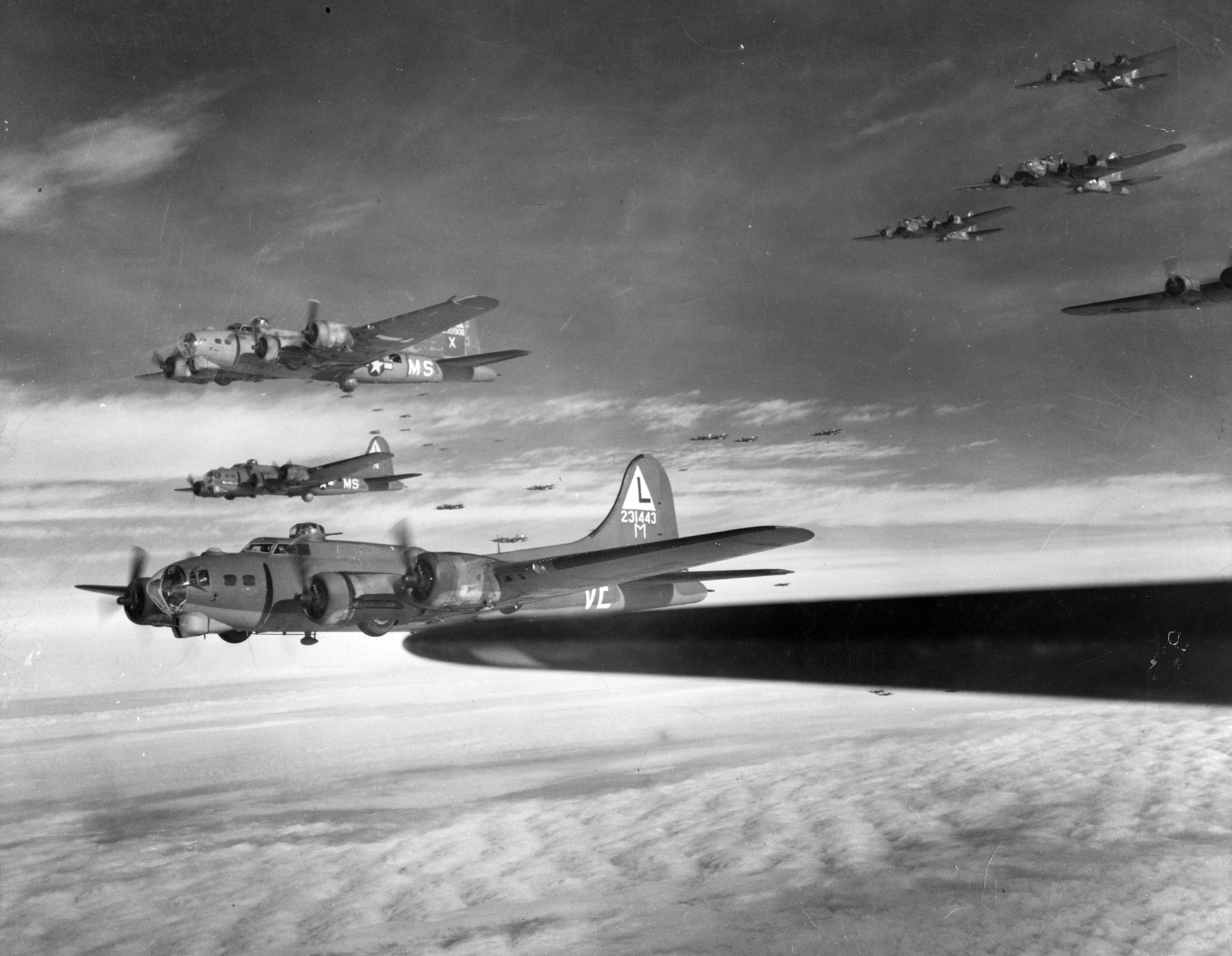
The Air Almanac is believed to be one of the greatest contributions to navigation in several decades. It has transformed celestial navigation from a very painful art to a near painless one. It has popularized the lunar observation -- rarely attempted before appearance of the publication. It has made the daylight fix by two bodies possible during those portions of the month when the moon is visible and well located.
—Air Force, The Official Service Journal of the U.S. Army Air Forces, Vol.26, No.1, January 1943, p.9.
In 1940, Columbia University Astronomy Professor Wallace Eckert left his Columbia post for the US Naval Observatory for the duration of World War II to serve as Head Astronomer and Director of the USNO's Nautical Almanac Office, which produced the almanacs used for air and sea navigation. When Eckert arrived and war was looming, there was a pressing need for rapid production of accurate and readable air almanacs for use by American flying forces; prior to this, only a couple air almanacs had been produced, and those by old-fashioned, slow, and error-prone manual methods. Eckert quickly adapted the machine methods he had perfected at Columbia to the Naval Observatory, setting up IBM machines to produce the almanacs with unprecedented speed and accuracy.
Under Eckert's guidance, the Air Almanac went through three stages: the 1941 issue (the first regular issue) was printed in the traditional manner, with hand-set movable type; the 1942-45 issues were printed directly on a modified IBM 405 accounting machine, and the 1946 and subsequent issues (through at least 1950) were printed on a Card-Operated Table Printer that Eckert designed in 1941, but which IBM did not deliver until 1945.
The American Ephemeris and Nautical Almanac, meanwhile, were gradually automated under Eckert's direction by Paul Herget; the pace in this case was more leisurely because the original Naval Observatory staff had long produced these using traditional methods (desktop calculators, copying, movable type) and it was less demanding (only one issue was needed per year with data listed per hour, rather than every ten minutes). As Eckert wrote (WJE/Haupt reference below):
The printing of the Air Almanac is a task of some magnitude, considerating the high standards of perfection which are required. There are three volumes each year with a total of 730 pages each containing about 3,000 figures. Some editions have run to nearly two hundred thousand copies and it has been necessary on occasion to make successive reprints of a given volume. The assurance of perfection in millions of copies with billions of figures requires great care, especially under wartime printing conditions. The need for perfection in the American Air Almanac is obvious. An erroneous figure could cause the loss of a valuable plane and crew. The figures must be easily legible since the aviator must read them quickly in a bouncing plane with poor illumination when he is tired, cold and short of oxygen. The volumes must be compact since they must be used cramped quarters.
Eckert and his staff achieved perfection through two innovations: printing computed values directly without transcription (starting with the 1942 Air Almanac), and machine checking of the results. New decks were punched from the final page proofs and compared with the original decks in a reproducer. As an additional check, differencing was performed on the data, up to the sixth difference, using the 405.
Eckert's Air and Nautical Almanacs were used by all American air and sea forces for navigation in both the Atlantic and Pacific theatres, as well as by civil aviation, Merchant Marine, and commercial shipping. Not one single error was ever reported. Eckert counted the production of these almanacs as his finest achievement, greater even than his calculations that guided the Apollo missions to the moon.
The other major allies, Britain and the USSR, it seems, produced their own air and sea almanacs, rather than sharing, despite the hardships (Britain was bombed by Germany from 1940, and the USSR was invaded in 1941). The RCAF might have used Eckert's Air Almanac, or might have used the British one. The Brazilian Air Force (which saw action in in Italy) probably used Eckert's. The Free French Air Force...? Probably the British.
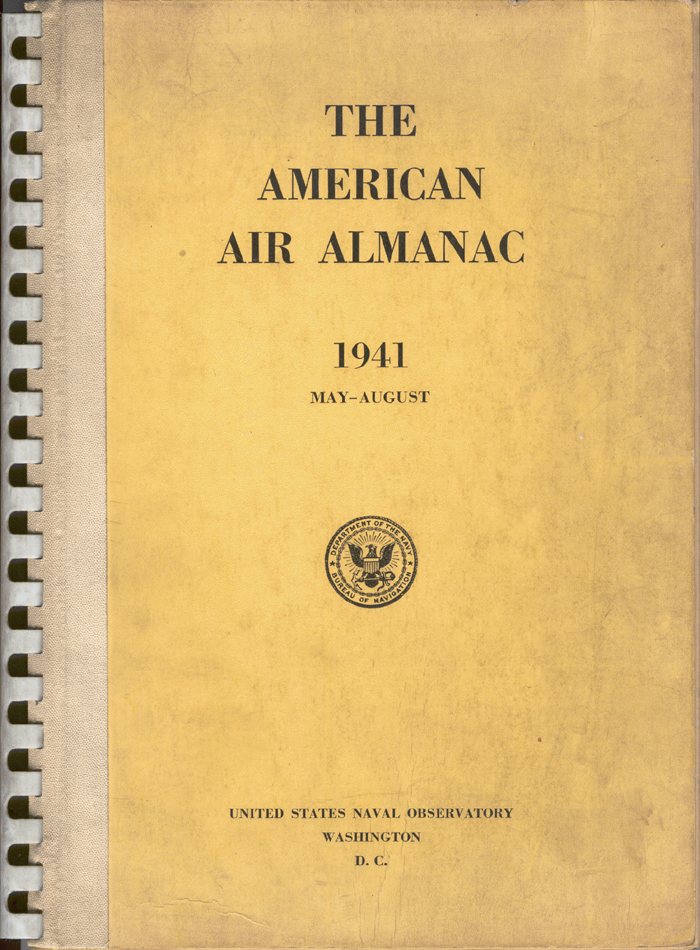
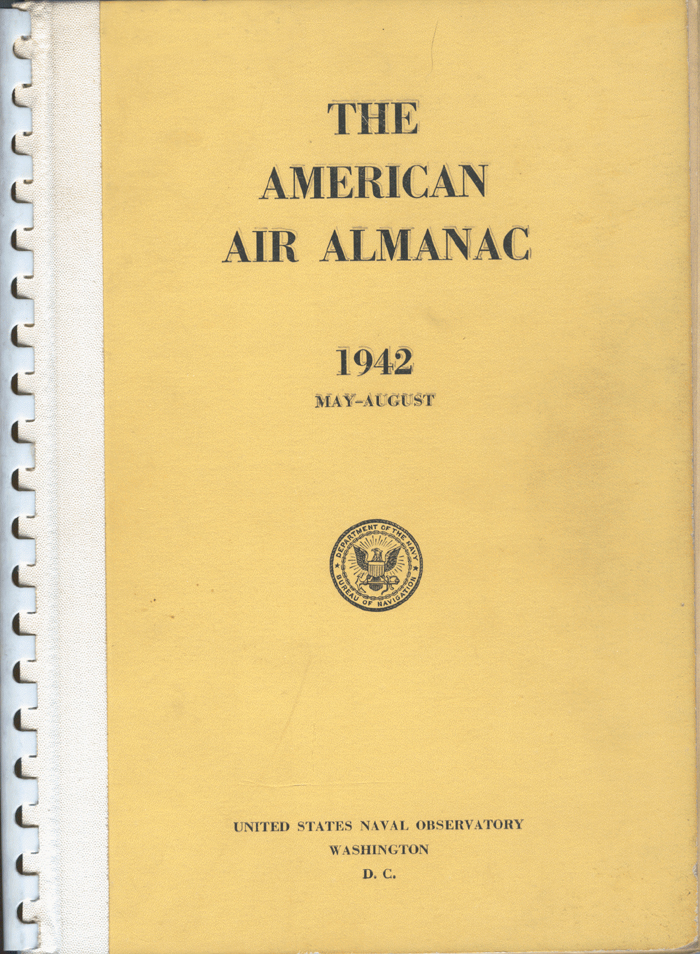
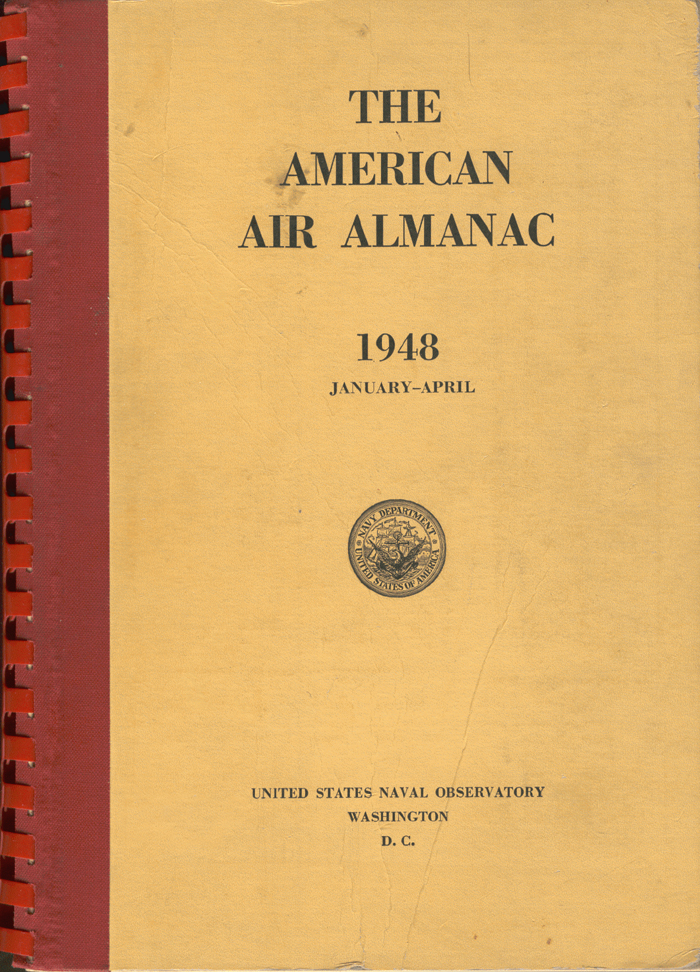
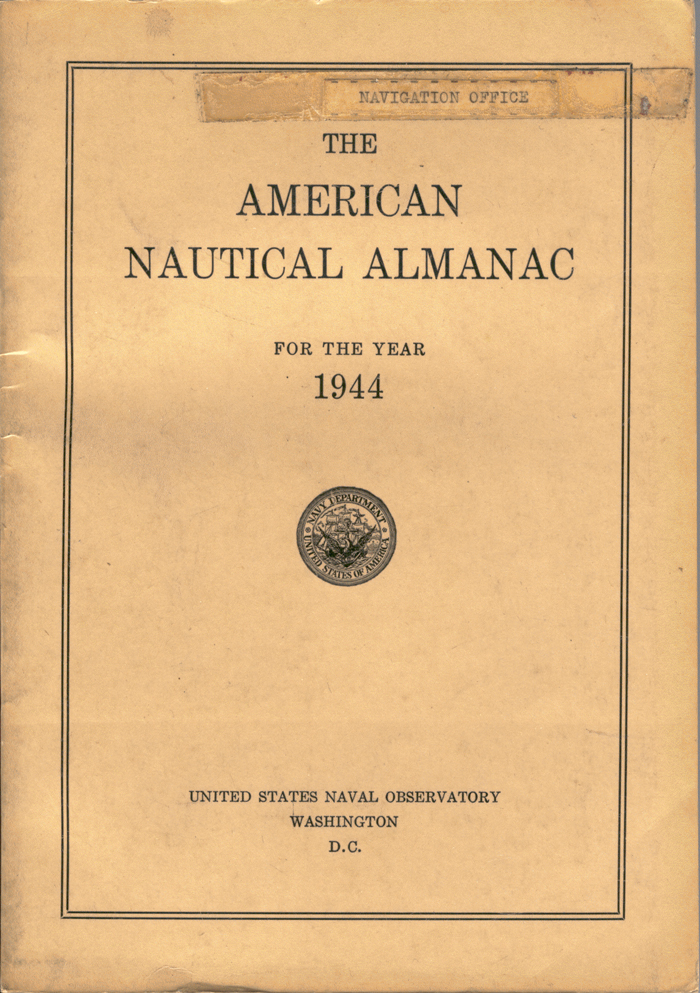
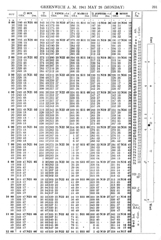
| The 1941 Air Almanacs were hand-set and printed in moveable type from figures calculated and printed on the Naval Observatory's IBM 405 Accounting Machine [84]. Eckert reports that the first page proofs contained 840 errors (more than one per page). The corrected proofs still contained 68 errors due to faulty correction of previous errors by the printer. Exhaustive checking was done until all errors were eliminated, a process Eckert characterized as "not only costly but ... demoralizing". The final results, however, were of the highest quality in terms of sharpness and clarity. CLICK ON IMAGE to magnify. CLICK HERE to view the title page. CLICK HERE to view the masthead. |
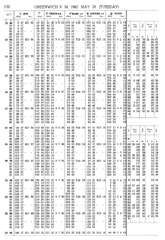
| The 1942 through 1945 Air Almanacs were totally automated to eliminate the labor and delay caused by hand setting and proofreading ("The second year, it occurred to us it was not satisfactory to have almost perfect data and have it mutilated in the printing…" [84]). But for the sake of clarity and sharpness, they could not simply be printed on standard 1930s-era printers, such as the one built into 405; the result is not sufficiently precise or compact (CLICK HERE to see a portion of an astronomical table printed on a standard 405), and anyway, the 405 could print a maximum of 88 characters per line (more were needed) and had certain other limitations (e.g. no alphabetics past column 43). Therefore a 405 was modified to use half-width typebars and to allow each page to be printed in two passes, odd card columns in one pass, even in the other, the second offset from the first by half a horizontal space, allowing 12 characters per inch rather than the normal six. |
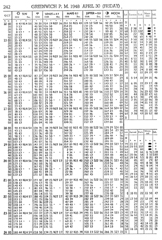
| Eckert's Card-Operated Table Printer arrived in February 1945, in time to produce the 1946 Air Almanac and subsequent issues. Grosch [57] describes it as "a black proportional spacing electric typewriter, which IBM had just begun to make in the Forties, in which most of the alphabetic characters had been replaced by extra numerical fonts: bold face, or small size, or small-size subscripts and superscripts; all designed to be harmonious. Automatic spacing was crippled, and put instead under external control. This was embodied in a … key punch, which read the stack of data cards … On such punches there was a rack for a master card, which rode back and forth in synchronism with the detail card. IBM had modified the circuits so that the holes punched in the master card now controlled the spacing of the typewriter. The results were extremely elegant…" |
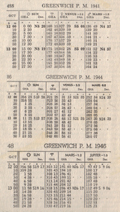
| This is Figure 2 from the WJE/Haupt article, showing the three printing methods for easy comparison. Notice the center example, from 405 Accounting Machine, exhibits the "jaggies" typical of vertical typebars (CLICK HERE for more about typebars), or slight misalignment of page on the first and second printing passes. The bottom example is from the Card-Operated Table Printer, for which the sans-serif Bell Gothic font was chosen (originally developed by Mergenthaler Linotype for printing telephone directories); notice the thin spacing between some of the columns and the perfect vertical and horizontal alignment. Thanks to Herb Grosch for this scan. |
- Private corrrespondence with Kenneth Seidelmann [92] (USNO historian) and Mary Croarken (Royal Observatory historian), April 2004 (about which Allies used which almanacs).
- Dick, Steven, "History of the American Nautical Almanac Office", The Eckert and Clemence Years, 1940-1958, in Fiala, Alan D., and Steven J. Dick (editors), Proceedings, Nautical Almanac Office Sesquicentennial Symposium, U.S. Naval Observatory, Washington DC, March 3-4, 1999, pp.35-46.
- Dick, Steven J., Sky and Ocean Joined: The U.S. Naval Observatory 1830-2000, Cambridge University Press (2002), ISBN 0-521-81599-1, 609pp (Ch.12, pp.519-523).
- Eckert, W.J., "The Construction of the Air Almanac", 68th Meeting of the American Astronomical Society, New Haven CT, 12-14 June 1942 [group photo].
- Eckert, Wallace J., Transcript, Systems Service Class No. 591 (Aerial Navigation) for the US Army Air Corps; Department of Education, International Business Machines, Endicott NY (8 Sep 1944).
- Eckert, W.J., "Air Almanacs", Sky and Telescope, Vol.4, No.37 (Oct 1944).
- W.J.E. (Wallace J. Eckert) and Ralph F. Haupt, "The Printing of Mathematical Tables", Mathematical Tables and Other Aids to Computation, Vol.2, No.17 (Jan 1947), pp.197-202.
- Grosch, Herbert R.J., Computer: Bit Slices from a Life, Third Edition, 2003 (in manuscript), Chapters 02 and 07. First edition published by Third Millenium Books, Novato CA (1991), ISBN 0-88733-085.
- Gutzwiller, M.C., "Wallace Eckert, Computers, and the Nautical Almanac Office", in Fiala, Alan D., and Steven J. Dick (editors), Proceedings, Nautical Almanac Office Sesquicentennial Symposium, U.S. Naval Observatory, Washington DC, March 3-4, 1999, pp.147-163.
- Hollander, Frederick H., "Punched Card Calculating and Printing Methods in the Nautical Almanac Office", Proceedings, Scientific Computation Forum, IBM, New York (1948).
- Mixter, George, W. "American Almanacs", in NAVIGATION, Journal of the Institute of Navigation, Vol.1, No.3 (September 1946).
- Seidelmann, P.K., P.M. Janiczek, and R.F. Haupt, "The Almanacs - Yesterday, Today, and Tomorrow", in NAVIGATION, Journal of the Institute of Navigation, Vol.24 No.4, Winter 1976-77, pp.303-312.
- The American Air Almanac: 1941-50, United States Naval Observatory, Nautical Almanac Office, Washington DC.
- The American Nautical Almanac: 1941-45, United States Naval Observatory, Nautical Almanac Office, Washington DC.
- United States Navy Nautical Almanac Office, "Tables of Sunrise, Sunset and Twilight", Supplement to the American Ephemeris, 1946, US Government Printing Office, Washington DC (1945), 196pp.
- Bowditch, Nathaniel, American Practical Navigator, H.O. No.9, United States Hydrographic Office under the authority of the Secretary of the Navy. United States Printing Office (1943).
- Just a Beginning: Computers and Celestial Mechanics in the Work of Wallace J. Eckert, Ph.D. Dissertation of Allan Olley, 31 August 2011.
- Navigation Then and Now, Attleboro, Massachusetts, Sun Chronical (22 Nov 2000).
- The Nautical Almanac Office - A Brief History (US Naval Observatory)
- Air Almanac History (USNO).
They don't exactly discuss the almanacs but they come close and they are excellent books. In a way I think the absence of anything on the almanacs in books like this is a tribute, because if there was ever a problem with any of them, the histories would be all over the topic. But the almanacs were so good, they were simply taken for granted.
- Combat America (Clark Gable made this movie himself in 1943)
- The Memphis Belle (William Wyler, 1944)
- Command Decision (Sam Wood, 1949)
Bombing missions from England to Germany and other targets. You don't actually see the almanacs, but you see crews including the navigators. There are tons of others in the same vein, maybe an almanac shows up in some of them.
Translations of this page courtesy of...
| Language | Link | Date | Translator | Organization |
|---|---|---|---|---|
| Belarusian | Беларуская | 2023/08/22 | Vladyslav Byshuk | Владислав Бишук | studycrumb.com |
| Finnish | Suomi | 2023/08/31 | Kerstin Schmidt | https://admission-writer.com/ |
| French | Français | 2023/08/31 | Kerstin Schmidt | prothesiswriter.com |
| German | Deutsch | 2023/08/31 | Kerstin Schmidt | writemypaper4me.org |
| Hungarian | Magyar | 2023/08/31 | Kerstin Schmidt | https://writemyessay4me.org/ |
| Italian | Italiano | 2023/08/31 | Kerstin Schmidt | https://pro-academic-writers.com/ |
| Polish | Polski | 2023/08/31 | Kerstin Schmidt | justdomyhomework.com |
| Russian | Русский | 2022-02-17 | (anonymous) | Jur Perevod Translation Agency |
| Slovak | Slovenčina | 2023/08/22 | Vladyslav Byshuk | Владислав Бишук | skyclinic.ua |
| Ukrainian | Українська | 2023/08/22 | Vladyslav Byshuk | Владислав Бишук | studybounty.com |